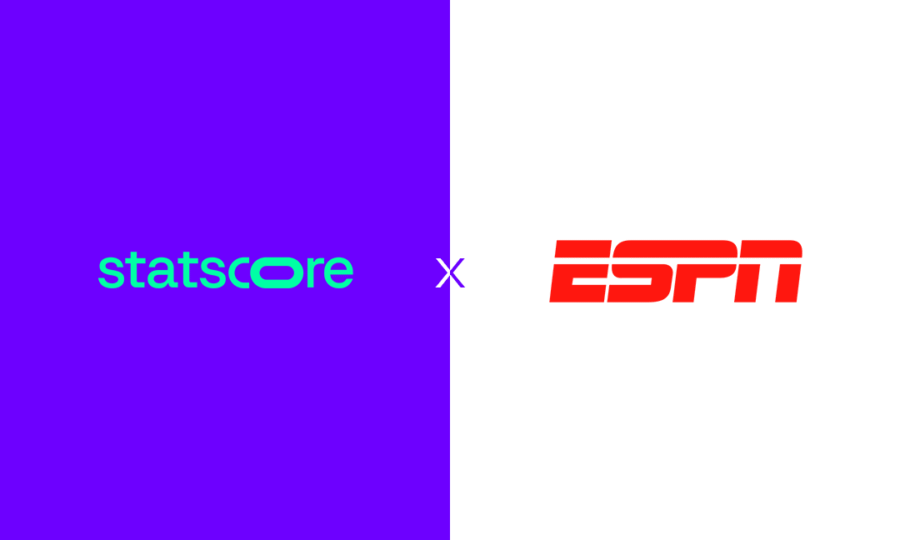Statscore signs new deal with ESPN Brazil to bring real-time data to live streams

Sports data and technology company Statscore has partnered with ESPN Brazil to bring its LivematchPro tracker to its digital programming and YouTube streams of televised matches.
The tool provides real-time statistics, visual updates, and key match insights alongside live commentary, improving the viewing experience. The collaboration aims to blend analysis with data visualization.
“We are honored to be chosen by a media powerhouse like ESPN Brasil to help shape the future of sports content,” Vice President of Sales at Statscore George Fotev said in a news release. “This partnership underscores the critical role of superior data visualization in meeting the demands of modern sports fans.”
The collaboration is designed to merge analysis with live performance data, and will be streamed on YouTube to create a complete and immersive match narrative for viewers across Brazil.
ESPN Brazil said that adding LivematchPro would further its goal of delivering smarter, data-driven sports coverage.
The partnership reinforces ESPN Brazil’s standing as a digital innovator in Latin American broadcasting and strengthens Statscore’s position as a global leader in sports data technology.
Last month, Statscore announced it had partnered with US-based predictions market Kalshi to bring its sports data to the platform.
Abi Bray brings strong researching skills to the forefront of all of her writing, whether it’s the newest slots, industry trends or the ever changing legislation across the U.S, Asia and Australia, she maintains a keen eye for detail and a passion for reporting.
Verticals:
Sectors:
Topics:
Dig Deeper
The Backstory
Why ESPN Brazil is turning to live data now
ESPN Brazil’s move to layer real-time tracking and visual insights over live match broadcasts reflects a broader shift in sports media toward data-led storytelling and integrated betting-era experiences. The network is plugging a gap that has widened as viewers split across broadcast, streaming and social platforms and expect instant context with every possession, pitch or point. By embedding a third-party tracker on digital programming and YouTube streams, ESPN Brazil is betting that granular play-by-play graphics and predictive signals can lift watch time, keep second-screeners engaged and create a measurable bridge between commentary and outcomes.
The strategy also aligns with a regional race to capture audience attention ahead of major tournaments that spike casual viewership. Brazil’s vast football base is increasingly consuming matches on mobile and social channels where overlays, charts and win-probability meters perform well. Bringing a live tracker into that flow aims to convert ambient interest into sustained sessions and, eventually, monetizable touchpoints like targeted ads or sponsor integrations.
Underpinning this push is the maturation of supplier-side tools able to capture, normalize and render live data with low latency. As rights holders loosen distribution on digital extensions, the door opens for visualization layers that sit on top of video without competing with the main feed. That allows broadcasters to differentiate coverage without renegotiating core rights.
Data suppliers extend their footprint from trading to media
The ESPN Brazil pact builds on a run of deals in which data vendors are moving beyond odds feeds or back-end analytics into consumer-facing experiences. A notable example is the three-year agreement between Statscore and prediction market operator Kalshi to power sports contracts with live inputs across football, tennis, basketball, ice hockey, baseball, Formula 1 and American football. That deal, detailed in coverage of the Statscore-Kalshi partnership, underscores how the same pipelines that price risk for trading desks can render digestible visuals for viewers.
There is a feedback loop at work. As trading venues require higher precision and quicker updates to support in-play markets, vendors invest in faster data acquisition and better modeling. Those upgrades make their way into media products that broadcasters can deploy as augmented graphics or second-screen dashboards. Kalshi’s recent scrutiny over football league imagery shows the reputational stakes that come with operating at the edge of sports IP, yet the underlying thesis remains: richer data is becoming a primary product for both bettors and fans.
For ESPN Brazil, rolling out a live tracker through a third-party partner lets it test and scale without building in-house. It also gives the network optionality to tune visualizations by sport, event and platform, then measure which elements drive retention or ad lift. If the experience boosts engagement, it can become a template for other ESPN regional units or licensed partners.
Media-betting convergence sets expectations for interactivity
The line between watching and wagering keeps thinning, particularly in the United States where sportsbook brands lean on media pipes to find customers. ESPN’s own experiment with that blend is accelerating. In Washington, the company’s co-branded sportsbook with Penn Entertainment debuted through Monumental Sports & Entertainment, expanding distribution to a 20th U.S. jurisdiction. The launch of ESPN Bet in D.C.—and its account linking with ESPN properties—cements a model where bettors toggle between odds, highlights and studio analysis inside the same ecosystem.
Those integrations raise the bar for interactivity outside the U.S. even in markets where regulated sportsbooks are separate from broadcasters. Fans trained to expect live lines, instant stats and contextual overlays will reward publishers that bring those features to nonbetting environments. ESPN’s responsible gambling messaging around “The Talk” shows another pressure point: as media and betting blend, networks face higher scrutiny to educate users and keep experiences safe.
Brazil’s market has its own regulatory path, but the product standard is set globally. A live tracker tied tightly to commentary is a low-friction upgrade that can migrate across leagues and languages without the compliance complexity of embedded wagering.
Latin America’s growth wave favors personalized, data-rich content
The timing in Latin America is favorable. Operators and suppliers are racing to capture users ahead of marquee events and regulatory momentum. CRM stacks built for igaming are entering the region to target players with individualized journeys that lean on activity data and event triggers. BetConstruct’s expanded tie-up with Fast Track brings exactly that playbook to local operators. As reported in the BetConstruct-Fast Track expansion, brands like Suprema Gaming and VBet are using automation to segment and engage customers in real time.
Personalization is not just for sportsbooks. Broadcasters can adapt the same logic—surface the right stat, angle or clip at the right moment—to maximize attention. With Brazil at the center of regional audience growth, data visualization that feels tailored to a match’s rhythm can deepen loyalty without heavy editorial lift. The approach mirrors how streaming platforms test thumbnails and intros. Sports media can A/B test possession heat maps, shot charts or momentum bars and optimize for time spent.
On the operator side, new entrants are pairing content with commerce. Mobile Streams’ launch of the Estadio Gana sportsbook in Mexico aims to blend live match updates, news and betting ahead of the 2026 World Cup co-hosted by Mexico, the U.S. and Canada. As platforms mix editorial and transactional experiences, demand grows for embeddable data layers that keep fans on site during live events. That dynamic boosts the value proposition for suppliers offering turnkey trackers to both media and betting partners.
Regulatory crosscurrents heighten the stakes for diversified models
Not all markets are trending permissive. India’s sweeping ban on real-money online gaming has hit operators overnight and serves as a caution for firms overly dependent on paid contests. Fantasy giant Dream11 said revenue fell by 95% after Parliament passed the Promotion and Regulation of Online Gaming Bill, according to reporting on Dream11’s warning. The company is exiting a major national team sponsorship, underscoring how policy can reshape economics for brands built on entry fees and cash games.
For broadcasters, that volatility argues for investment in engagement tools that do not hinge on betting outcomes. Real-time stats and visualizations remain lawful in restrictive regimes and can help retain audiences even if monetization must rely on advertising or subscriptions. For data suppliers, balancing clients across trading platforms, sportsbooks and media companies spreads risk while broadening use cases for the same core feeds.
Brazil sits between these poles. As lawmakers refine rules and operators jockey for share, media companies that lead with compliant, high-utility features can capture attention without waiting on the regulatory finish line. If rules later allow deeper betting integrations, the infrastructure will be in place.
What to watch next
Expect ESPN Brazil to test deeper integrations around big matches, from customized dashboards to sponsor activations tethered to key moments. Uptake from younger viewers on YouTube will be a signal that the tracker can scale. Watch for data vendors to announce more media-facing tools as a complement to their trading products, building on precedent from the Kalshi tie-up. In Latin America, CRM-led operators like those highlighted in the BetConstruct-Fast Track agreement will push for tighter personalization, which could nudge broadcasters toward audience-level data strategies of their own.
In the U.S., the continued rollout of ESPN Bet will shape expectations for interactive coverage worldwide. In Mexico, Estadio Gana’s launch shows how content plus live data can anchor user acquisition around tentpole events. And in India, fallout from the real-money gaming ban will keep reminding media and betting firms that product agility and diversified revenue matter as much as audience size.








